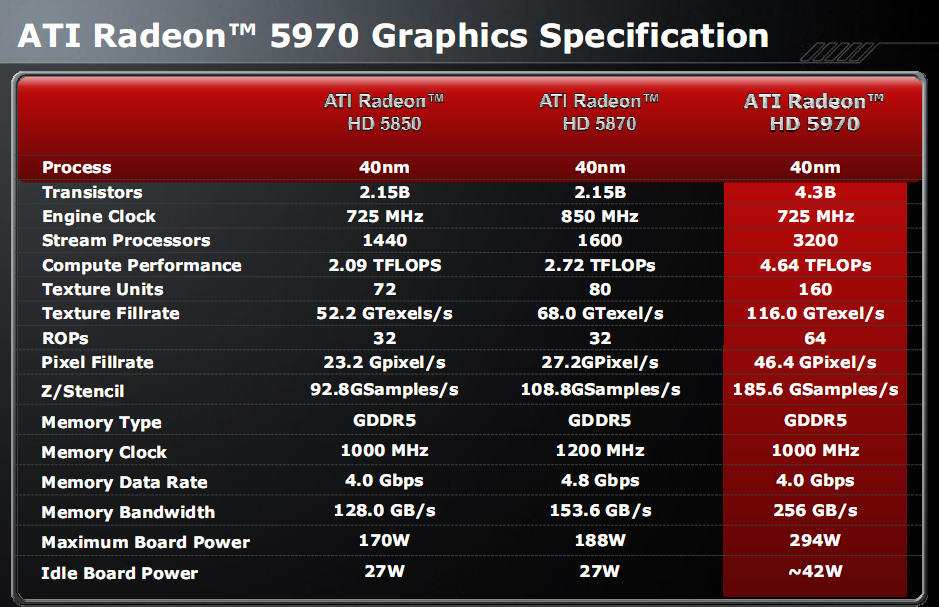Install the app
How to install the app on iOS
Follow along with the video below to see how to install our site as a web app on your home screen.
Note: This feature may not be available in some browsers.
You are using an out of date browser. It may not display this or other websites correctly.
You should upgrade or use an alternative browser.
You should upgrade or use an alternative browser.
AMD: R8xx Speculation
- Thread starter Shtal
- Start date
Err, what is RV810 really?
TPU claims 200 ALUs, but why would it be cut down to 80ALUs for any laptop revision then?
They say "expected" but I thought Cedar was less than half of Redwood? (I was actually saying 120SP a while back, disappointed at 80.)
Silent_Buddha
Legend
That hypothesis is only valid if changing the GPU has no effect on the rest of the system. We know for a fact that is not true. Bottlenecks shift and there are higher/lower loads placed on other system components that also consume power.
Sure but that's going to be the exact same case with just attempting to measure GPU only. So there's absolutely no difference there either. Other than measuring GPU only gives you a false power use number as you don't get the power increase due to the GPU offloading to other parts of the system. Power consumption that is directly attributable to the GPU.
Measure from the wall will still mean that power difference is going to be purely due to the change in GPU with a small modifier for PSU efficiency. Only in this case, you'll have a better and more accurate idea of how your power consumption will be affected by X GPU versus Y GPU. As you then completely negate the uncounted power consumption caused by the GPU if it offloads more work to the CPU or other system components when attempting to isolate the GPU.
Just as a broad example. Take a GPU with zero video acceleration or video decode help. Meaning all of that work must be offloaded to the CPU. Now take a GPU that accelerates video. Measuring just the GPU while playing a video won't provide an accurate picture of how those GPUs increase power consumption. The GPU with zero video accerlation will quite probably draw far less power when isolated from the system (all other specs being equal), but your system is now consuming far more power than with the GPU that is doing the video acceleration on board.
Someone might look at those power numbers for an isolated GPU and think. Wow the GPU without video accerlation would be a better choice for my low power HTPC, when that wouldn't be the case, assuming his CPU could play whatever he required which would be just about any desktop (non-atom, non-via) CPU now sold.
Regards,
SB
Last edited by a moderator:
Err, what is RV810 really?
TPU claims 200 ALUs, but why would it be cut down to 80ALUs for any laptop revision then?
(It's not RV710, DX11 and all)
"It will make for two initial product SKUs: the Radeon HD 5400 series (probably Cedar with GDDR3 memory), and Radeon HD 5500 series (probably Cedar with GDDR5 memory). There are three models slated for release later this month: Radeon HD 5450, Radeon HD 5550, and Radeon HD 5570."
According to it168 from previously in the thread the 5570 is Redwood based SDDR3 part.
Would think logically Cedar GDDR5 was 54xx, Cedar DDR3 was 53xx and the IGP 52xx.
Edit: Looking at the arabhardware.net pictures cant quite make out code on the samsung memory chip K4W1G1646E-HC11 i think but looks like some kind of GDDR3 at 1800MHz and seems to be detected as 5450...so i guess if they are going to put out a GDDR5 part at all only number left is the 5470. 53xx must be for something else
Last edited by a moderator:
DavidGraham
Veteran
ATi can't have 120SPs , each cluster has 80 SPs , so it's either 80 or 160 .They say "expected" but I thought Cedar was less than half of Redwood? (I was actually saying 120SP a while back, disappointed at 80.)
Anyway , According to some user at Arabhardware , the card is 80SPs :
http://www.arabhardware.net/forum/showthread.php?t=153600
gamervivek
Regular
ATi can't have 120SPs , each cluster has 80 SPs , so it's either 80 or 160 .
Anyway , According to some user at Arabhardware , the card is 80SPs :
http://www.arabhardware.net/forum/showthread.php?t=153600
ati can and have had 120SP cards already, *cough* 4670 *cough*.
DavidGraham
Veteran
HD4670 has 320SPs !ati can and have had 120SP cards already, *cough* 4670 *cough*.
HD4670 has 320SPs !
Cedar is a bit weird in that in other respects too, it only has 4 Display Pipelines instead of the 6 that the rest of the family sport.. but anyway.. it has been 80SP's for quite some time now.
gamervivek
Regular
HD4670 has 320SPs !
in 8 groups!!!
DavidGraham
Veteran
So ?in 8 groups!!!
PCPOP HD5670 review:
http://translate.google.cn/translat...cpop.com/doc/0/488/488100.shtml&sl=auto&tl=en
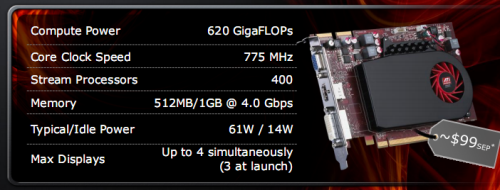
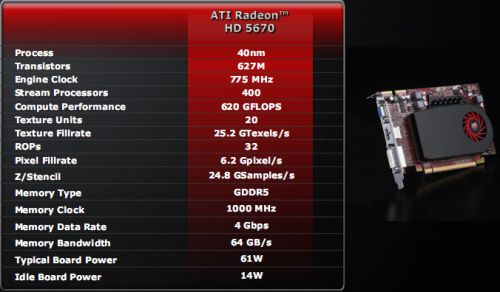

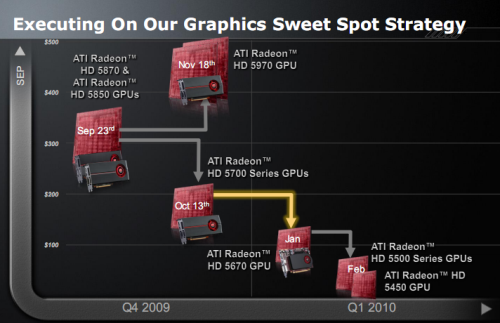 [/QUOTE]
[/QUOTE]
http://translate.google.cn/translat...cpop.com/doc/0/488/488100.shtml&sl=auto&tl=en




hoom
Veteran
unless you're 'playing' a power virus...TDP figures are a max number for the SKU variant, actual results will vary alot (below) the rated TDP
So ?
ATi has 20 (4 SPU x 5), 40 (8 SPU x 5) or 80 (16 SPU x 5) stream processors per SIMD since RV6xx series. Very flexible.
RV610 has 2(SIMD) x 20 sp -> 40 sp
R600/RV670 has 4(SIMD) x 80 sp -> 320 sp
RV630/RV635 has 3(SIMD) x 40 sp -> 120 sp
RV710 has 2(SIMD) x 40 sp -> 80 sp
RV730 has 8(SIMD) x 40 sp -> 320 sp
RV740 has 8(SIMD) x 80 sp -> 640 sp
RV770/RV790 has 10(SIMD) x 80 sp -> 800 sp
Juniper has 10(SIMD) x 80 sp -> 800 sp
Cypress has 20(SIMD) x 80 sp -> 1600 sp
Redwood has 5(SIMD) x 80 sp -> 400 sp
Cedar has... 2 x 40 sp (or 1 x 80 sp?)
IGPs has... 2 x 20 sp? or (or 1 x 40 sp?)
bye
Misprint/typo on the number of ROPs?
Should be 8ROPs...
Edit- Was talking about 5670.
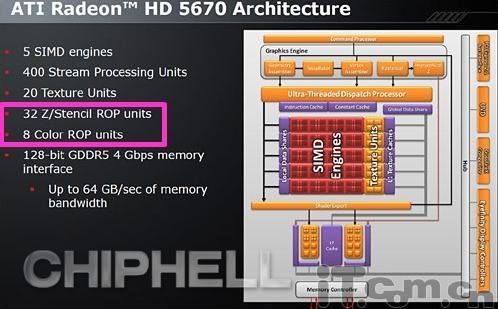
Pretty sure IGPs are the same as the discrete parts, hence 2x4(x5).Cedar has... 2 x 40 sp (or 1 x 80 sp?)
IGPs has... 2 x 20 sp? or (or 1 x 40 sp?)
If Cedar really is only 80SPs, I'd certainly expect it to be 2x8(x5) too.
btw I'm always wondering what those smaller arrays actually do for performance. Apart from the obvious (different ALU:TEX ratio), batch size is smaller which should result in better performance in theory...
edit: just for clarity, don't forget r6xx had tmus shared across simds, rather than the tmus being part of the simds. Hence rv610/ipgs have 4 tmus, not 8 (with 1 simd they'd have 8).
Last edited by a moderator:
digitalwanderer
Legend
I can't say anything about the 5670 performance or nothing yet, but now that there is a picture of it public...ISN'T IT JUST ADORABLE?!?! 
Similar threads
- Replies
- 17
- Views
- 5K
- Replies
- 220
- Views
- 93K
- Replies
- 90
- Views
- 18K
- Replies
- 172
- Views
- 24K


